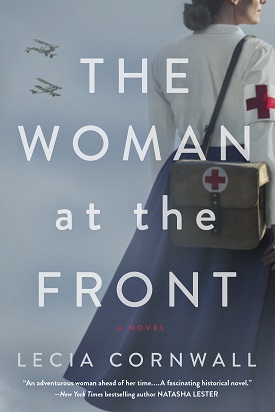 Synopsis:
Synopsis:
When Eleanor Atherton graduates from medical school near the top of her class in 1917, she dreams of going overseas to help the wounded. But her ambition is thwarted at every turn. Eleanor’s parents insist she must give up medicine, marry a respectable man, and assume her proper role and place in society. While women might serve as ambulance drivers or nurses at the front, they cannot be physicians — that work is too dangerous and frightening for young women.
Nevertheless, Eleanor is determined to make more of a contribution than sitting at home knitting for the troops. When an unexpected twist of fate sends Eleanor to the battlefields of France as the private doctor of a British peer, she seizes the opportunity for what it is — the chance to finally prove herself.
But it’s war. And a casualty clearing station close to the front lines is an unforgiving place. Eleanor faces skeptical commanders who question her skills, scores of wounded men needing care, underhanded efforts by her family to bring her back home . . . and an unexpected romance with a most unlikely man.
Is Eleanor brave enough to break the rules, face her darkest fears, and take the chance to win the career — and the love — she’s always wanted?
In A Woman at the Front, a daring young woman risks everything to pursue her long dreamed-about career as a doctor on the front lines in France during World War I. In the process, she learns the true meaning of hope, love, and resilience in the darkest times.
Review:

Author Lecia Cornwall is certain she was born in the wrong century because she has “always been more comfortable with history than modern life — except for essential modern conveniences . . .” including immersion blenders and computers. She lives in Canada’s Rocky Mountains and has penned fifteen novels, of which The Woman at the Front is her first foray into historical fiction. Hopefully, it won’t be her last.
The book was inspired by a conversation Cornwall had with her grandfather, who served as a gunner during World War I, when she was about fifteen years old. Her great-uncle served as an infantryman — right on the front lines, while her grandfather ad the other gunners remained tucked well behind. Her grandfather didn’t learn until a few days after the battle that his brother had been killed. All those years later, he asked Cornwall to find her great-uncle’s grave. When she, accompanied by her children, visited the burial site, she was moved to pen a story set during World War I. Cornwall dedicated The Woman at the Front to the great-uncle she never knew, who died on April 9, 1917, as well as her grandmother, “who told me his brother’s story and made me promise never to forget.”
While conducting research for the book, Cornwall learned that the British government permitted women to serve only as ambulance drivers or nurses, but “felt it was too frightening, too dangerous, too disturbing” for men to be treated female doctors. Rather, women who graduated from medical school and went on to serve as physicians were required to limit their practices to treating only women and children because because of a belief that there were “some things women could not handle.” The French did not wholeheartedly share those views and welcomed female doctors — but kept them off the front lines of battle.
As The Woman at the Front opens, Eleanor Atherton has applied to serve for overseas medical service and been invited to an interview with an undersecretary in the War Office. However, when the undersecretary learns “E. Atherton” is sitting before him, he unsurprisingly fumes, “Young woman, my advice to you is to go home, sit down, and take up something more useful, such as knitting.” Which is precisely why Eleanor used only her first initial. “Miss Atherton” had already been rejected by every bureaucrat she had contacted by letter or attempted to meet with in person. But she will not be dissuaded, reminding the undersecretary that her father, Dr. John Atherton, was once an army doctor and her brother, Edward, is serving at French headquarters. Eleanor, age twenty-three, graduated seventh in her class from the University of Edinburgh just eight months earlier. Her class was comprised of more than one hundred and thirty men — and just two women.
Undaunted, Eleanor accepts the only assignment offered. She agrees to travel to France to accompany Louis Chastaine home, at the request of his mother, a countess. Eleanor has long had a crush on Louis, whose brother was killed just a few months ago. Being lauded as a hero, Louis sustained a broken leg when the plane he was piloting was shot down over France. The countess is determined that Louis return at once to carry out his responsibilities to his family and title as the last Chastaine heir.
For all of her wealth and privilege, the countess recognizes that Eleanor’s talents are not being put to use — solely because of her gender — revealing she asked that Eleanor assist at the convalescent hospital but her father declined the request on Eleanor’s behalf. He also asked that the countess not disclose the discussion to Eleanor, who is outraged by her father’s “high-handed decision.” When the countess reminds Eleanor that she has powerful friends who can ensure the development of her career, Eleanor agrees, even though she recognizes that the countess is using her “as bait, something feminine and soft to dangle before Louis, a siren to lure him home,” despite her recognition that she is the “least siren-like woman in all England.” Even though she is being presented a dare, Eleanor also knows she is being offered an adventure and, at last, “her chance to prove herself, to truly be a doctor.” Over her parents’ objections, the next chapter of Eleanor’s life begins.
Of course, Eleanor is not prepared for what she encounters. Her trip has barely begun when she is accosted on the train by a group of rowdy soldiers. She is rescued by a Scottish sergeant, Fraser MacLeod, who explains that he serves not as a doctor, but as a stretcher bearer. At six-foot-five and strong, he was selected and trained “to find wounded men on the battlefield, to stop bleeding, give morphine, bandage wounds under fire, and get them back to where a medical officer can do more.” Fraser begins educating Eleanor on the realities of war and when they reach the Casualty Clearing Station where Louis is being treated, she is informed that Lieutenant Chastaine will not be able to travel for weeks . . . and is a problematic patient. She is warned that Colonel Belford, who is in charge of the Casualty Clearing Station, will definitely perceive her presence as meddling . . . and has the authority to order her to leave. Indeed, he only relents and permits her to stay when Eleanor presents written permission to attend to Louis, issued by a regimental commander who outranks him.
Louis, whose injury is severe enough that it could still result in the loss of his leg, behaves like the spoiled, entitled, and roguish aristocrat he is. He is surrounded by hangers-on who see the war as an inconvenience, popping champagne and partying in the medical facility with no regard for the other wounded soldiers they are disturbing. But Louis is clearly fond of Eleanor because of their shared history and the fact that Edward is his best friend. “Under his careful facade of charm and careless courage, she suspected there was much more.” And before the book’s end, Cornwall reveals whether Eleanor’s hunch about Louis is accurate.
Eleanor soon gets her wish — the rules be damned, she is pressed into service as a doctor when the war demands it. Convention no longer matters when men are wounded and there are not enough male doctors to treat them all. Cornwall, who endears Eleanor to readers at the outset, takes them along with her on a harrowing journey. Danger, death, disillusionment, and fatigue are everywhere and inescapable, and Eleanor fervently works alongside the other medical personnel to save as many wounded as she possibly can. She learns to catch a few brief hours of sleep when there is a brief respite, practicing medicine under unimaginably horrible conditions without sufficient supplies of medication, bandages, and other essentials. She comes to understand the necessity to triage the wounded by recognizing that some are beyond her ability to save them and providing comfort to those unfortunate victims of battle as best she can. Days pass during which she and her fellow medical professionals do not rest or see daylight because they remain on their feet tending to the endless stream of wounded who are delivered to the facility by Fraser and his fellow stretcher bearers.
Cornwall’s thorough research and command of her subject matter is evident throughout the fast-paced, riveting tale. It is a gritty, unsparing portrait of the fulfillment of Eleanor’s dream of serving, even though she finally gets the chance to practice medicine under conditions that can only be described as nightmarish. Cornwall surrounds Eleanor with a compelling cast of supporting characters, including fellow doctors who reluctantly and begrudgingly come to respect her talent and tenaciousness. Among those characters is Matron Connolly, the stern, procedural stickler who oversees the nursing staff and resents the presence of a female doctor in the ward she manages. Can Eleanor impress Matron Connolly enough to win her over? Some of Cornwall’s characters heartbreakingly succumb to wounds, as well as influenza as it sweeps across Europe and claims soldiers, doctors, nurses, and civilians. “Someone who was healthy in the morning might collapse in the afternoon with fever and die before the next dawn.”
The story would be less enthralling absent the eventual revelation of family secrets that make Eleanor’s experiences even more meaningful and, of course, the feelings that develop between Eleanor and Fraser. But stretcher bearers “have a bad habit of betting killed, and there’s never enough trained men to replace them.” Will Fraser survive the war? And even if he does, will Eleanor’s attraction to him survive, as well? After all, they come from different socioeconomic classes, and Fraser intends to return to Scotland when the war finally ends.
The Woman at the Front is a beautifully crafted coming-of-age story. Cornwall believably and compassionately chronicles Eleanor’s evolution from an inexperienced but qualified doctor yearning to utilize the knowledge and skills she has acquired to a seasoned physician who faces every challenge with courage, commitment, and resilience. Readers will find themselves unable to put the book down until they learn the fate of every one of Cornwall’s characters.
World War I does not provide the background for engrossing historical fiction nearly as frequently as does World War II. Cornwall wants readers to remember that it was an important era because it marked a time of great “change in warfare and medicine and so many other things . . .” and is replete with poignant, moving, and frequently tragic stories of sacrifice, loss, and triumph. Like the fictional accounts she includes in the story.
Cornwall hopes readers are inspired by The Woman at the Front and that her depiction of Eleanor’s experiences convincingly demonstrates the “good things that can come out of hardship as well. And we certainly need that these days.”




Comments are closed.